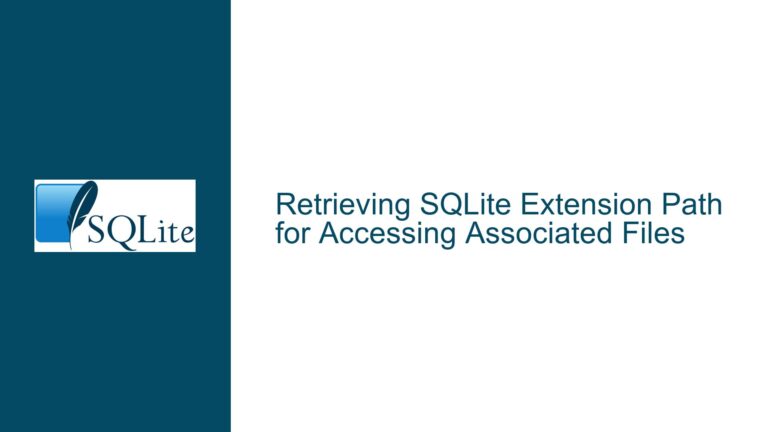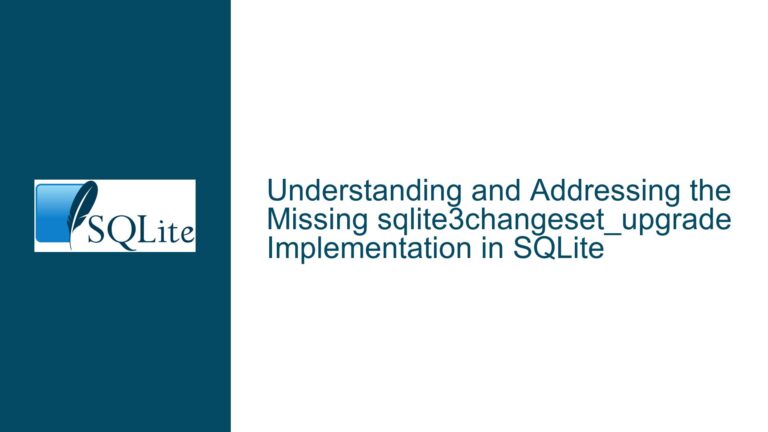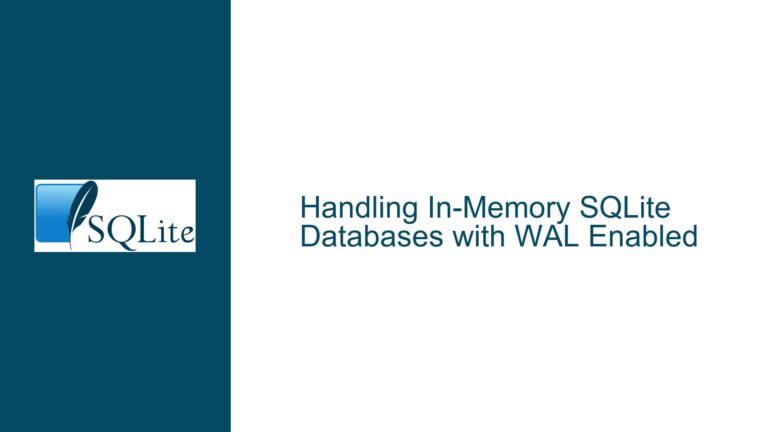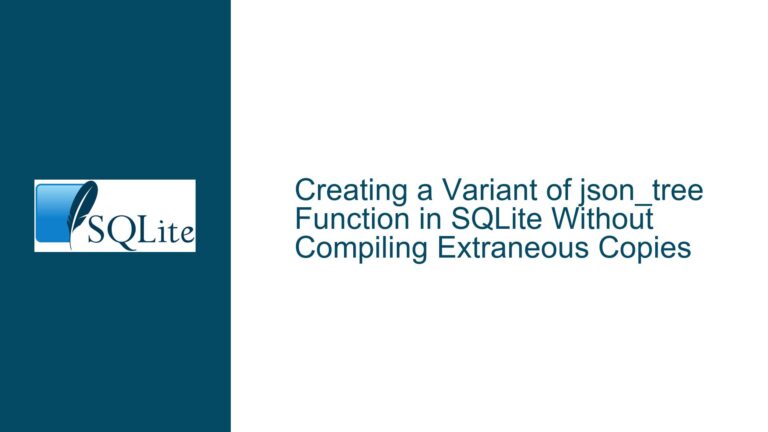Resolving ODBC Driver Installation Failures and Bitness Mismatch in SQLite on Windows
Issue Overview: ODBC Driver Installation Failures and Bitness Compatibility Challenges
The core issue revolves around difficulties encountered when attempting to install or utilize SQLite ODBC drivers on a Windows 10 64-bit system, specifically when targeting SQLite databases for programmatic access. The primary symptoms include installation errors such as "Error Opening File for writing: C:\Program Files\SQLite ODBC driver for Win64\sqlite3odbc.dll" and subsequent failures to establish ODBC connections from external applications like MS Access or custom codebases.
This problem is multifaceted, involving permission conflicts, file-locking mechanisms, bitness mismatches between applications and drivers, and misunderstandings about SQLite’s architecture. The discussion highlights a critical dependency chain: ODBC drivers must align with the bitness (32-bit or 64-bit) of the client application, and installation processes must account for Windows security policies governing system directories like C:\Program Files.
A secondary layer of complexity arises from the distinction between SQLite’s core library (sqlite3.dll or sqlite3.exe) and third-party ODBC drivers. Unlike traditional database systems, SQLite does not include ODBC connectivity out-of-the-box, necessitating reliance on external drivers such as those provided by Christian Werner. Misconfigurations in driver installation or bitness alignment often lead to opaque errors, leaving users uncertain whether the fault lies in their driver setup, application code, or SQLite itself.
Possible Causes: Permission Conflicts, Bitness Mismatches, and File Locking
1. Insufficient Privileges During Installation
Windows enforces strict access controls over the C:\Program Files directory. Even if a user account has administrative rights, modern Windows versions often require explicit elevation via User Account Control (UAC) prompts when modifying system directories. The error "Error Opening File for writing" strongly suggests that the installer lacked sufficient privileges to create or overwrite files in C:\Program Files\SQLite ODBC driver for Win64. This is exacerbated when:
- The installer is launched without "Run as Administrator" context.
- Antivirus or endpoint protection software intercepts file operations.
- Prior installations left residual permissions misconfigured.
2. File Locking by Active Processes
The sqlite3odbc.dll file may be locked by a running process, preventing its overwrite during installation. Common culprits include:
- Background services or applications that loaded the DLL (e.g., previously configured ODBC data sources).
- Lingering instances of SQLiteStudio, ODBC Data Source Administrator, or other database tools.
- System-wide hooks or monitoring tools that inspect DLL activity.
3. Bitness Mismatch Between Application and ODBC Driver
ODBC drivers operate as in-process components, meaning they must match the bitness (32-bit or 64-bit) of the client application. A 64-bit application cannot load a 32-bit ODBC driver, and vice versa. This mismatch manifests as cryptic errors during connection attempts, often misinterpreted as driver installation failures. Key scenarios include:
- Installing a 64-bit ODBC driver but attempting to use it from a 32-bit application (e.g., legacy MS Office versions).
- Mixing driver versions (e.g., 32-bit driver from one vendor with 64-bit driver from another).
- Assuming Windows 10’s 64-bit architecture universally supports all driver bitness configurations.
4. Incorrect Driver Version or Corrupted Installer
Third-party ODBC drivers for SQLite, such as those from Christian Werner’s repository, may have version-specific dependencies or bugs. For example:
- Drivers compiled against outdated SQLite core libraries may fail with newer database files.
- Incomplete downloads or corrupted installer executables (
sqliteodbc_w64.exe) can truncate critical files. - Confusion between "Win64" (Itanium) and "x64" (AMD64) architectures in older driver packages.
5. Misconfigured System Environment Variables
While less common, environment variables like PATH or ODBCINST may reference outdated or conflicting driver entries, leading the installer or runtime to resolve incorrect file paths.
Troubleshooting Steps, Solutions, and Fixes
Step 1: Resolve Installation Privileges and File Locking
A. Run Installer with Elevated Privileges
- Right-click the ODBC driver installer (
sqliteodbc_w64.exeorsqliteodbc.exe). - Select Run as administrator to bypass UAC restrictions.
- If the error persists, temporarily disable antivirus/anti-malware software and repeat the installation.
B. Identify and Terminate Locking Processes
- Open Task Manager (Ctrl+Shift+Esc) and navigate to the Details tab.
- Use the Resource Monitor (resmon.exe) to search for handles to
sqlite3odbc.dll:- Under the CPU tab, type
sqlite3odbc.dllin the "Search Handles" field. - Identify processes holding the DLL and terminate them.
- Under the CPU tab, type
- For advanced diagnostics, use Sysinternals Process Explorer or handle.exe:
handle64.exe -p sqlite3odbc.dllTerminate offending processes or restart the system to clear locks.
C. Manual Installation and Directory Permissions
- Create the target directory manually:
mkdir "C:\Program Files\SQLite ODBC driver for Win64" - Grant full control to your user account:
- Right-click the directory > Properties > Security > Edit > Add your user > Check Full control.
- Extract the installer contents using 7-Zip or similar tools, then copy files manually to the directory.
Step 2: Address Bitness Mismatch and Driver Configuration
A. Determine Application Bitness
- For MS Access:
- Open Task Manager > Details tab > Check if
MSACCESS.EXEhas "32-bit" in the Platform column.
- Open Task Manager > Details tab > Check if
- For custom applications:
- Compile or check project settings for
x86(32-bit) vs.x64(64-bit) targets.
- Compile or check project settings for
B. Install Corresponding ODBC Driver
- 32-bit Application: Use
sqliteodbc.exe(32-bit driver). - 64-bit Application: Use
sqliteodbc_w64.exe(64-bit driver).
C. Configure ODBC Data Source Correctly
- Open the appropriate ODBC Data Source Administrator:
- 32-bit:
C:\Windows\SysWOW64\odbcad32.exe - 64-bit:
C:\Windows\System32\odbcad32.exe
- 32-bit:
- Add a User DSN or System DSN with the correct driver.
- Test connectivity using the Test Connection button if available.
Step 3: Validate and Repair Driver Installations
A. Verify DLL Integrity and Dependencies
- Use Dependency Walker (
depends.exe) onsqlite3odbc.dllto check for missing dependencies. - Ensure
msvcr120.dll(Visual C++ 2013 Redistributable) or similar runtime libraries are installed.
B. Clean Reinstall and Registry Checks
- Uninstall the ODBC driver via Control Panel > Programs and Features.
- Manually delete residual directories (e.g.,
C:\Program Files\SQLite ODBC driver for Win64). - Use Registry Editor (
regedit.exe) to remove orphaned entries under:HKEY_LOCAL_MACHINE\SOFTWARE\ODBCHKEY_LOCAL_MACHINE\SOFTWARE\WOW6432Node\ODBC
C. Alternative ODBC Drivers and Providers
If Christian Werner’s driver remains problematic:
- Experiment with Devart ODBC Driver for SQLite (commercial).
- Use Microsoft ODBC Driver Manager in combination with SQLite’s core DLL.
Step 4: Advanced Diagnostics and Fallback Strategies
A. Enable ODBC Tracing
- Open ODBC Data Source Administrator.
- Navigate to the Tracing tab > Start tracing.
- Reproduce the error and analyze the log for connection string or driver failures.
B. Leverage SQLite’s Native Connectivity
Bypass ODBC entirely by using native libraries:
- C#: Utilize
Microsoft.Data.SqliteorSystem.Data.SQLite. - Python: Use
sqlite3module orpyodbcwith direct SQLite support.
C. Virtual Machine or Containerized Testing
Isolate environmental variables by testing the driver installation in a clean Windows VM or Docker container.
By methodically addressing permissions, bitness alignment, and environmental factors, users can resolve ODBC driver installation issues and establish robust connectivity to SQLite databases. Persistent problems often stem from overlooked process locks or subtle bitness mismatches, necessitating a disciplined approach to system and application configuration.






